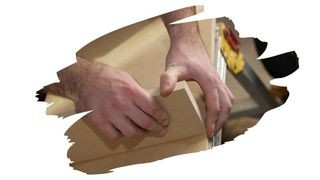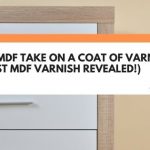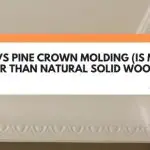If you want a truly blemish free MDF surface, then you might need to use some wood filler. It really is that simple.
If you don’t, then those nail holes all along that MDF trim are going to stand out…even through a coat of paint.
But, while wood fillers pair well with natural solid wood, their performance can be more hit and miss when it comes to MDF.
So, why wouldn’t you simply use something like Polyfilla instead? This product can be used on wooden surfaces, so why not MDF too?
Well, in this post, you will learn why not all wood fillers work well on MDF’s composite material. You will also discover what the key differences are between Polyfilla and Wood Filler (despite their many similarities).
And we explain what this means for applying Polyfilla onto MDF. So, let’s get into it…

This post may contain affiliate links to products that we receive a commission for (at no additional cost to you). Learn more here.
What’s The Best Way To Fill Holes In MDF?
A bit of wood filler will work nicely at filling in any gouges. Wood filler can be sanded down and painted onto too. But, it cannot take any penetrating finishes (such as oil-based wood stain).
So if you plan on finishing MDF, (with a coat of paint or an otherwise clear sealer), then wood filler will get the job done.
Related Post: Wood Filler Showing Through Paint? Fix It In 3 Easy Steps! | The Woodwork Place
What Does Wood Filler Do Exactly Anyway?
Wood filler works kind of like a sealer, but instead of waterproofing the surface of wood, it packs out any gouges or holes. It then dries into a hard tough substance.
So, Can You Easily Add A Wood Filler To MDF?
Wood filler can be applied to wood, and MDF is a wood composite. Which means that wood filler will adhere to an unfinished MDF surface.
In fact, it is a great way to pack and hide those tiny nail holes left in newly installed MDF trim.
Related Post: What’s The Best Nailer For MDF Trim? | The Woodwork Place
What’s The Best Filler For Filling In MDF Joints?
When it comes to MDF, not all types of fillers work well with this manufactured wood. This is because MDF soaks up water readily, and is easily water damaged.
Once water gets underneath the surface of this composite material, it takes a really long time to dry out again. This, in turn, gives wood rot plenty of time to do its worst to this engineered wood.
So, MDF’s ability to absorb water at an incredibly fast rate puts a limit on the kind of finish you can use on it.
Now, water-based wood fillers set faster than their solvent-based counterparts, because their water content allows them to dry and evaporate more efficiently.
However, if you apply water-based wood filler, MDF will soak up that fillers water content…well before the filler has had time to properly set.
So, always stick to using solvent based wood filler, when it comes to fixing damaged MDF surfaces.
And Is Polyfilla A Wood Filler Too?
No, it isn’t, although it does act in a similar way to wood filler. Instead, Polyfilla is a spackling paste, the kind used by painter decorators to repair small imperfections in concrete and brick.
And just like wood filler, Polyfilla can be sanded down and painted over as well.
While it tends to be used mostly on concrete and brick, Polyfilla can also be applied onto wood grain. So, this paste can be used to mask any dints and dents in MDF’s surface.
Can You Use Polyfilla To Fill In Brad Nail Holes In MDF? When it comes to tiny screw holes, Polyfilla will easily cover those visible brad nail holes.
To Sum Up, Here Are The 3 Key Takeaways From This Post…
- 1). The best way to fill in holes on MDF is to use a solvent-based wood filler.
- 2). Polyfilla isn’t wood filler (in the traditional sense). However, it can still be used to hide small holes in MDF.
- 3). Both wood filler and Polyfilla can be sanded, and painted. However, neither one will absorb a penetrating finish.
Reference:
Bahri, M. A. S., M. M. Ratnam, and HPS Abdul Khalil. “Functionally graded wood filler–recycled polypropylene composite: Effect of mechanical loading on deflection of cantilever beam.” Advanced Composites Letters 29 (2020): 2633366X20922856.



